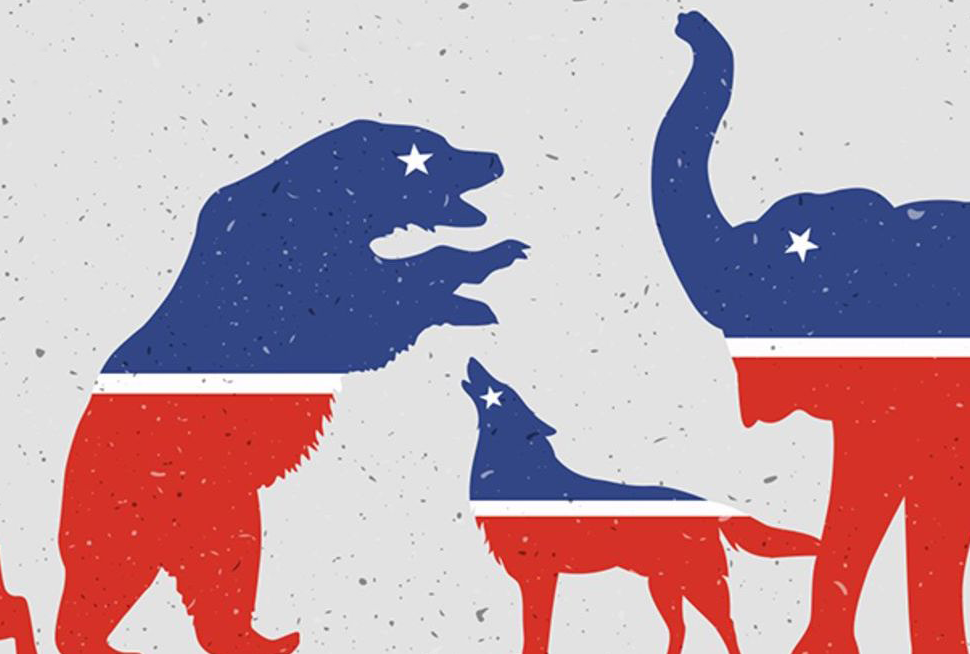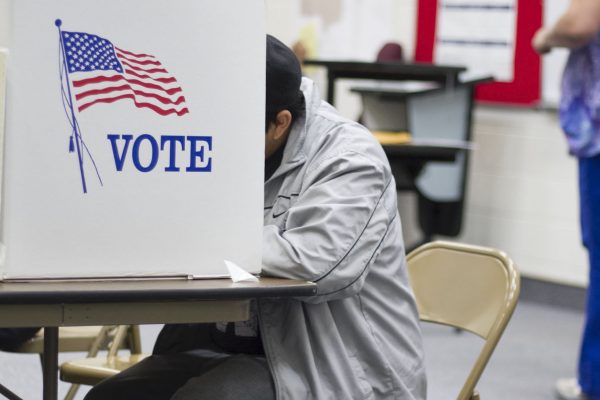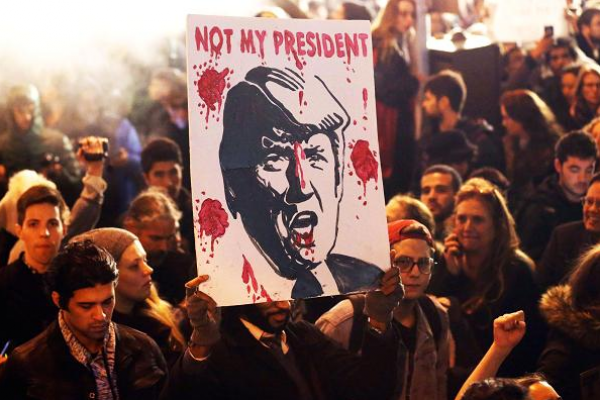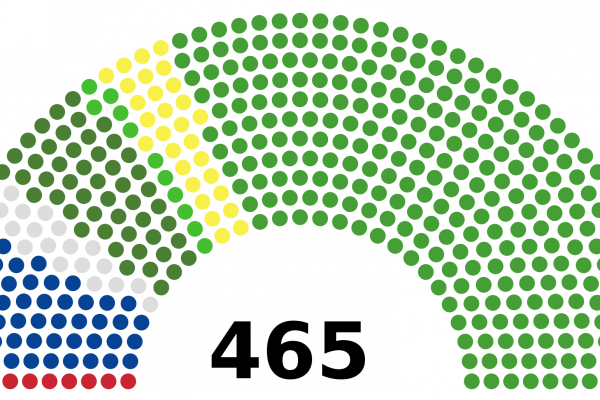Breaking the Two-Party Doom Loop: The Case for Multiparty Democracy in America
Lee Drutman
Oxford University Press, $27.95 (cloth)
“In any other country, Joe Biden and I would not be in the same party,” Alexandra Ocasio-Cortez told New York Magazine late last year. “But in America, we are.” The democratic socialist’s discomfort at sharing a party with centrist liberals captures the most common criticism of America’s entrenched party duopoly: that it muzzles a diversity of political views. Dissident political movements across history—from Eugene Debs’s socialists to Henry Wallace’s anti–Cold War progressives, George Wallace’s reactionary populists to Ralph Nader’s Greens—have long complained about the Tweedle Dee and Tweedle Dum of Republican and Democratic Party domination.
Classic U.S. two-partyism appears to be hurtling the country over a precipice of constitutional crisis.
Although that complaint has often come from the edges of the political spectrum, whether left or right, another venerable line of attack has come from would-be centrist White Knights. Lamenting polarized partisanship, they call on common-sense moderates to come together to support solutions for the common good. And though such centrist efforts often take the practical form of a third-party movement, what they really represent is less advocacy for multiparty politics in the long-term than anti-partyism as a political ethic.
Breaking the Two-Party Doom Loop, Lee Drutman’s new brief for multipartyism in America, falls squarely outside of both of these traditions. A political scientist and fellow at the New America Foundation, Drutman is neither a radical nor a pox-on-both-houses centrist, but rather a perfectly mainstream liberal. He’s also—blessedly—no anti-party man, insisting explicitly and repeatedly that parties perform the essential task of structuring conflict in politics, and that “stronger political parties make for stronger democracy.” The core motivation driving his case for transformative electoral reform is less utopian than restorative—a small-c conservative desire to bring some stability and functionality back to the political system. In the face of hoary myths about the chronic instability of multiparty systems, Drutman synthesizes reams of comparative scholarship to show that, in fact, they more often than not inculcate norms of compromise and incrementalism—while classic U.S. two-partyism appears to be hurtling the country over a precipice of constitutional crisis.
The bulk of the book offers a sweeping account of the origins and dynamics of contemporary party polarization, showing how the interplay between disciplined partisan warfare and a deliberately fragmented constitutional structure has now locked U.S. politics into a rolling crisis with “no mechanism for self-correction.” It’s as a last-ditch effort to break this dynamic that Drutman champions reforms that would lead to more parties. He insists that both the origins and potential solutions to the crisis are fundamentally institutional in nature—stemming from the rules of U.S. politics and the organizations that engage them.
Ultimately, Drutman is not convincing that his chosen reform would work as he envisions. But the journey he takes us on to reach his prescription provides a compelling portrait of the political death spiral in which we find ourselves trapped. “Time is precious,” he concludes, opting for a tone of maximalist panic. “The levees have broken. We cannot take buckets to the flood anymore.” I have my doubts that multipartyism provides the life raft we need to escape Drutman’s two-party doom loop. But I do get the “doom” part.
Targeting the two-party system to address our current crisis might seem odd at first blush. After all, our party duopoly is nearly as old as the country itself, while our politics appears to have gone haywire—in Drutman’s sense, at least—only much more recently. Why blame the duopoly?
Drutman terms the new dynamic “pendulum politics”—a perpetual scrimmage over the tantalizing moving target of majority control.
In a brisk but vivid historical tour, Drutman argues that the formal continuity of the two-party system actually masks a more fluid and fragmented dynamic in U.S. party politics up until a few decades ago. He channels the late historian and political scientist James MacGregor Burns in identifying a “four-party system” throughout the postwar era, with both parties containing bona fide conservative and liberal factions: conservative and liberal Republicans, conservative and liberal Democrats. Those intraparty divides obscured interparty distinctiveness. But that blurriness also enabled shifting bipartisan coalitions to legislate on a continuing, incremental basis, while keeping institutional power in Congress decentralized among committee chairs and policy entrepreneurs unburdened by heavy-handed party leaders.
This arrangement wouldn’t—probably couldn’t—last. Since southern white Democrats were central to this system, sustaining it required keeping civil rights off the forefront of political conflict. The black freedom struggle, aided by the broader agitation of northern Democratic liberals, finally made that impossible. In the later 1960s and 1970s there followed a related, rolling array of newly salient culture-war battles. In the maelstrom, the group coalitions of the two parties scrambled, then sorted. By the 1980s, a self-perpetuating dynamic of party polarization—driven by both group identity and ideology—had locked into place. Racially and culturally conservative white Democrats, especially but not only in the South, decamped to the GOP. Through a parallel but more purposeful and thoroughgoing process, the conservative movement consolidated control of the Republican Party and muzzled its moderates.
Throughout this period, politics grew increasingly nationalized: national party allegiances came more and more to determine down-ballot choices in state and local races. As a result, the two parties entered a prolonged phase of electoral parity at the federal level, to an extent unseen in over a century. That put control of major parts of the government in plausible contention every election cycle, and ideological sorting ratcheted up the stakes of losing control. Channeling the work of political scientist Frances Lee, Drutman terms the new dynamic “pendulum politics”—a perpetual scrimmage over the tantalizing moving target of majority control. Under competitive pressure, he writes, “parties have sharpened their rhetoric and waged more emotionally performative battles.” This in turn has made “cross-partisan compromise even more unlikely. . . . Electioneering takes over. Governance recedes.” Rinse and repeat.
Drutman is a nimble chronicler of this doom loop’s historical origins; only occasionally does he lapse into reductionism or misguided shorthand. (An “Old Left” really did once exist, for example, but it most certainly did not include “big city bosses and police.”) To convey what is genuinely novel about two-party dynamics in their current form, he would have benefited from widening his historical frame to include the nineteenth century, encompassing what historians call the “Party Period” in U.S. politics. The parties dominated electoral politics and governance more comprehensively between the 1830s and the 1890s than any time before or since, and we can see in those decades long stretches of vigorous party competition sustaining system-wide stability—as well as a descent into catastrophic civil war. His more proximate account nevertheless gives us what we need to understand how the ingredients of contemporary political conflict have acted like a toxic solvent on the functioning of government.
For Drutman, both the origins of and solutions to the crisis are institutional in nature—stemming from the rules of U.S. politics and the organizations that engage them.
Once you’re locked in a doom loop of polarized party competition, the temptation to manipulate procedural democracy to secure victory grows powerful, as does the logic used to justify it. National and state governments alike engage in high-stakes brinkmanship and skullduggery: voter ID laws and other procedural hurdles to voting, envelope-pushing efforts by lame-duck legislatures to strip powers from incoming officials of the opposite party, and increasingly explicit partisan justifications for aggressive gerrymandering. “As the country pulls apart, the stakes of each election rise,” Drutman summarizes. “As the stakes rise, the fighting toughens. As the fighting toughens, it becomes harder to agree on what’s fair.” Ominously, just such breakdowns in shared norms about what constitutes political fair play have accompanied major episodes of democratic backsliding in other countries.
It should be noted—and Drutman does—that Republicans have occupied the vanguard of contemporary efforts to push the procedural envelope. But liberals, with a long tradition of procedural reformism, have recently taken an interesting turn in their thinking about rules and institutions. Polarized conflict with the GOP has sensitized many Democratic activists and operatives to the myriad ways that the political system impedes majoritarian progressive politics. Many now embrace a much more aggressive and radical set of reform prescriptions: call it goo-goo hardball. Proposals not merely to undo the Senate filibuster or curb gerrymandering but also to end lifetime tenure for Supreme Court justices, pack federal courts, scrap the Electoral College, admit new states into the union, and effectively abolish the Senate have entered both public and intellectual discussion with new force. There are sound small-d democratic arguments for all of these reforms. But the partisan impetus behind their newfound currency is obvious. The title of political scientist David Faris’s recent book-length case for maximalist procedural warfare captures the inexorable logic of party politics caught in a doom loop: It’s Time to Fight Dirty.
Drutman has his own radical procedural fix to sell, but with a difference. He sees his prescription as an escape hatch out of the doom loop rather than a tool to aid one side in the party war.
Contrary to myths of instability, Drutman shows that multiparty systems inculcate norms of compromise and incrementalism.
Drutman only recently came to embrace multiparty democracy as the solution. Throughout 2016, he predicted that Trump’s rise would initiate a classic realignment of the two-party system around a new cosmopolitan-versus-traditionalist cultural divide. The transition to that new alignment would, he argued, depolarize policymaking for a time by reviving hidden and informal “four-party”-style coalitions. Trumpist Republicans and Sanders–style left populists might collaborate on economic and trade legislation, while upscale Republicans and cosmopolitan Democrats ally on immigration, reproductive rights, and environmental policy. That prediction has not held water, of course. Three and half years into Trump’s presidency, bipartisan coalitions like these are nowhere to be found. Party attachments have proven far stickier than Drutman (and others) imagined or hoped. Within the GOP, moreover, plutocratic economic interests have shown no sign of reevaluating their partnership with the ethno-nationalist populism that mobilizes the votes they need to pursue their agenda. Now that the chances of a two-party shakeup look virtually nil, Drutman looks to multiparty democracy as a Hail Mary pass to save the political system.
Is breaking the party duopoly feasible, even in the abstract? It can seem as natural, and unmovable, as bedrock. “The two-party system,” political scientist Clarence Berdahl wrote in 1951, “is so much a part of our governmental and political structure that it need not be argued, nor explained, nor even understood; it is, like the Constitution and the Monroe Doctrine, something we accept as a matter of course.” However well ensconced in the political culture it may be, Drutman is right to insist that the system owes its tenacity not primarily to Americans’ behavior or preferences but rather to a core set of electoral rules.
Every congressional district selects one House representative, just as every state in a given election cycle selects one senator and the country writ large selects one president. Each one of these positions is filled through plurality elections: whoever gets the most votes wins. (The Electoral College complicates matters when it comes to presidential selection, but the same principle applies to state-level presidential voting.) In such contests, multicandidate fields can produce perverse outcomes: the least liked candidate may be victorious if relatively likeminded voters split their choices. Voters thus have an incentive to avoid such “spoiler” effects, as do potential candidates themselves. Over time, these strategies stabilize into regular two-sided contests in every election.
The axiom that democracies with single-member districts and plurality elections produce stable two-party systems is known as Duverger’s Law, after French scholar Maurice Duverger. (It’s a testament to Drutman’s commitment to accessibility that he never uses Duverger’s name in the book, but he does explicate the law through a description of a Simpsons episode.) The U.S. political system further entrenches the party duopoly through state governments’ administration of primary elections and control over inclusion on election ballots. But the core of the matter is the single-member plurality rules.
Drutman targets his prescriptions accordingly. He calls on Congress to pass a law mandating multimember ranked-choice voting for selecting House members—assigning more than one representative for each district—as well as single-member ranked-choice voting for choosing senators. The ranked-choice method asks voters to list their candidate preferences in order. (In single-member contests, if no candidate gets a majority, the lowest ranked candidates get eliminated and their voters’ second choices are awarded the votes. The process is repeated until someone garners a majority.) Such a process does away with the strategic voting that encourages two-party contests. At the same time, it incentivizes parties to select candidates with broad appeal rather than simply those that will stoke their bases.
Some of the benefits that Drutman attributes to multipartyism would seem to depend on parliamentary presumptions.
Drutman’s proposed multimember House districts—complemented by an additional prescription to enlarge the size of the chamber itself—would introduce what is known as “proportional representation” into the U.S. legislature. Whatever the number of representatives in each district (Drutman suggests five), the top-ranked choices from the voting process would get that many seats. The candidates would be grouped by party on the ballot, allowing for party-line voting and for the allocation of seats to parties proportional to their voter support. This, in turn, would further encourage the emergence of stable multiparty democracy. Since cohesive political factions would be able to institutionalize themselves as competitive parties in such a system, Drutman also suggests doing away with congressional primaries, which weaken parties organizationally. As for presidential elections, in the absence of either an unlikely constitutional amendment or the success of the “state compact” workaround to undo the Electoral College, Drutman calls on states to allocate their electoral votes via ranked-choice voting.
It’s not until quite far into his book that Drutman lays out his full case for why the reforms he proposes, and the multiparty system he expects them to facilitate, would solve our political crisis. He dutifully pays heed to the most “obvious” benefit of multiparty democracy—that it increases “diversity of representation”—before moving to the core of the matter. Even though multipartyism enables parties to be more ideologically cohesive and differentiated in their electoral appeals, it has a track record of relatively consensual and stable governance. Elections in multiparty settings—which are, to be clear, the norm rather than the exception among developed democracies, from Australia to Sweden to Germany—tend to feature less negative campaigning and a greater focus on policy. Most importantly, the system “regularizes compromise and coalition building” as a built-in expectation of politics, since a single party rarely if ever wins an outright majority.
This expectation colors every aspect of the electoral process. “If voters learn what politics should be about through electoral campaigns,” Drutman argues,
multiparty and two-party democracy communicate different messages. Multiparty democracy communicates that democracy is about building coalitions and alliances. Two-party democracy communicates that democracy is about the true majority triumphing.
Moreover, in the worst-of-both-worlds U.S. case, aggressive majoritarianism and the all-or-nothing qualities of our contemporary electoral appeals coincide with a uniquely fragmented and veto-laden legislative process, in which legislative minorities can and do frequently block any policy from even happening. Locked in a polarized power struggle, Americans yearn continuously for the catharsis of victory—but get deadlock instead.
That deadlock brings us to a weakness in Drutman’s argument. He is right that the proximate driver of the legislative stalemates, government shutdowns, and recurring crises we see in U.S. politics is an institutional problem. But two-partyism may not be the key institution. Drutman’s account underplays the effects of another structure that puts the United States among a global minority of democracies: the separation of powers, otherwise known as presidentialism. Most democracies are parliamentary systems: governments are formed by legislative majorities, and the chief executive does not have a separate electoral connection to voters. Without separate executive and legislative branches, there’s no possibility of “divided government,” with opposing party coalitions controlling coequal parts of the government simultaneously. If the governing coalition can’t hold itself together, it dissolves and a new election is held. Some of the benefits that Drutman attributes to multipartyism would seem to depend on parliamentary presumptions.
In a multiparty democracy, plutocrats might still prefer gridlock to consensual compromise. The separation of powers is what would enable them to get it.
Consider the language Drutman uses to depict the smoother sailing of multiparty democracy in his hypothesized alternative. Smaller parties—a MAGA party, a Bloombergian neoliberal party, a Sanders left party, and so on—would first be able to make coherent electoral appeals, but would then turn around and “bargain with each other” when in power, “because they have to in order to govern.” Much hinges on that “have to.” The words have real meaning in a parliamentary system, where a governing coalition would dissolve in the face of a deadlock and have to call new elections. But a presidential system allows for sustained, grinding periods of gridlock and stasis when different parties control different branches simultaneously. (Look around!) Would fragmenting the legislature even further with more parties grease the wheels of negotiation and bargaining—or merely add new means and motivation for minorities to grind policymaking to a halt?
The record of multipartyism in presidential systems—a combination most commonly seen in Latin America—gives some cause for concern. Presidents, unlike prime ministers, don’t represent multiparty coalitions. Facing multiparty legislatures in which a majority of members are not of their party, presidents often struggle to build support for their agenda. Besides gridlock, this can lead to presidents aggrandizing powers to their office, or else buying legislative support via large-scale corruption. Drutman addresses the conventional scholarly skepticism of multiparty presidentialism, pointing out that more recent Latin American experience has been more encouraging, and emphasizing that gridlock is already a problem for two-party presidentialism in any case. That’s true, but it does little to assuage suspicions that our fragmented constitutional structure, rather than our party system, lies at the heart of our current crisis.
I suspect that Drutman’s electoral reforms would mark a net improvement over the status quo in terms of both normative democracy and governance. But much would depend on how a shakeup of the institutional landscape of politics might affect the strategies of its organized players. Think back, for example, to those moneyed elites hitching their regressive economic agenda to the coattails of Trumpian populism, and thwarting the party realignment that Drutman had heralded four years ago. It’s true that, in a multiparty context, the party of Trump would no longer need to be the party of Koch. But those plutocrats might still prefer the policy stasis born of gridlock to some consensual compromise—and the separation of powers is what would enable them to get it.
Even if Drutman falls short in clinching his prescriptive case, he succeeds fully in forcing the question. If multiparty democracy is not the answer to the crisis he conveys with such sweep and clarity, then what is?
Just as importantly, Drutman never fails to keep front and center his commitment to parties as bedrock features of electoral democracy. Given that real-word proponents of reforms such as ranked-choice voting include many advocates interested in weakening and decentering parties from politics rather than shifting to multipartyism, Drutman’s insistence that “the antiparty vision belongs to the dustbin of history” poses an important challenge. Parties perform tasks in electoral democracies that no other institutions do—organizing and channeling conflict, mobilizing citizens and connecting them to government, policing the boundaries of acceptable political participation. Contemporary political pathologies arguably stem as much from serious weaknesses plaguing the major parties—hindering their ability to carry out those democratic tasks—as from the virulent strength of mass partisanship.
Here’s to the improved health of the parties, however many we end up with.








